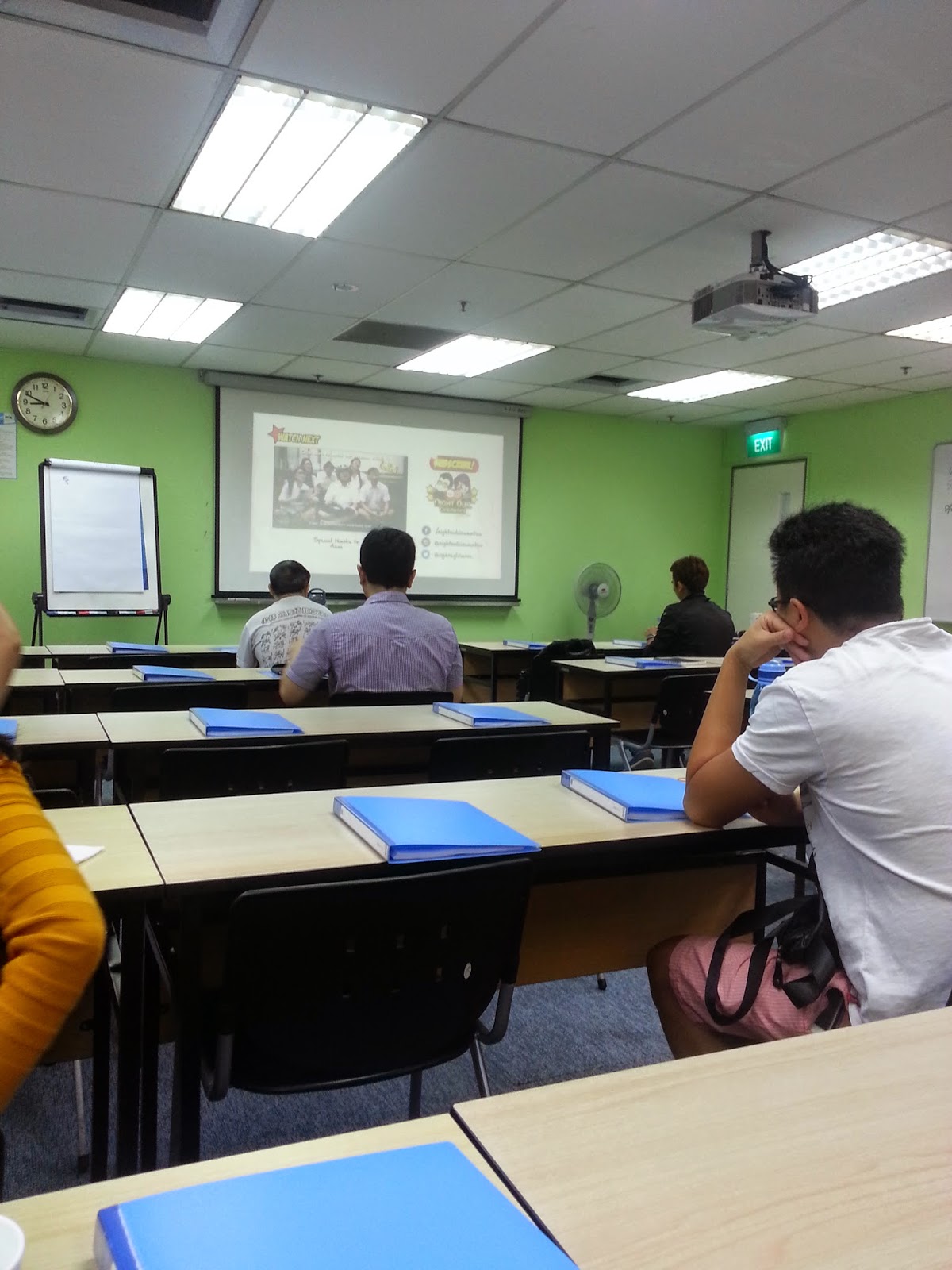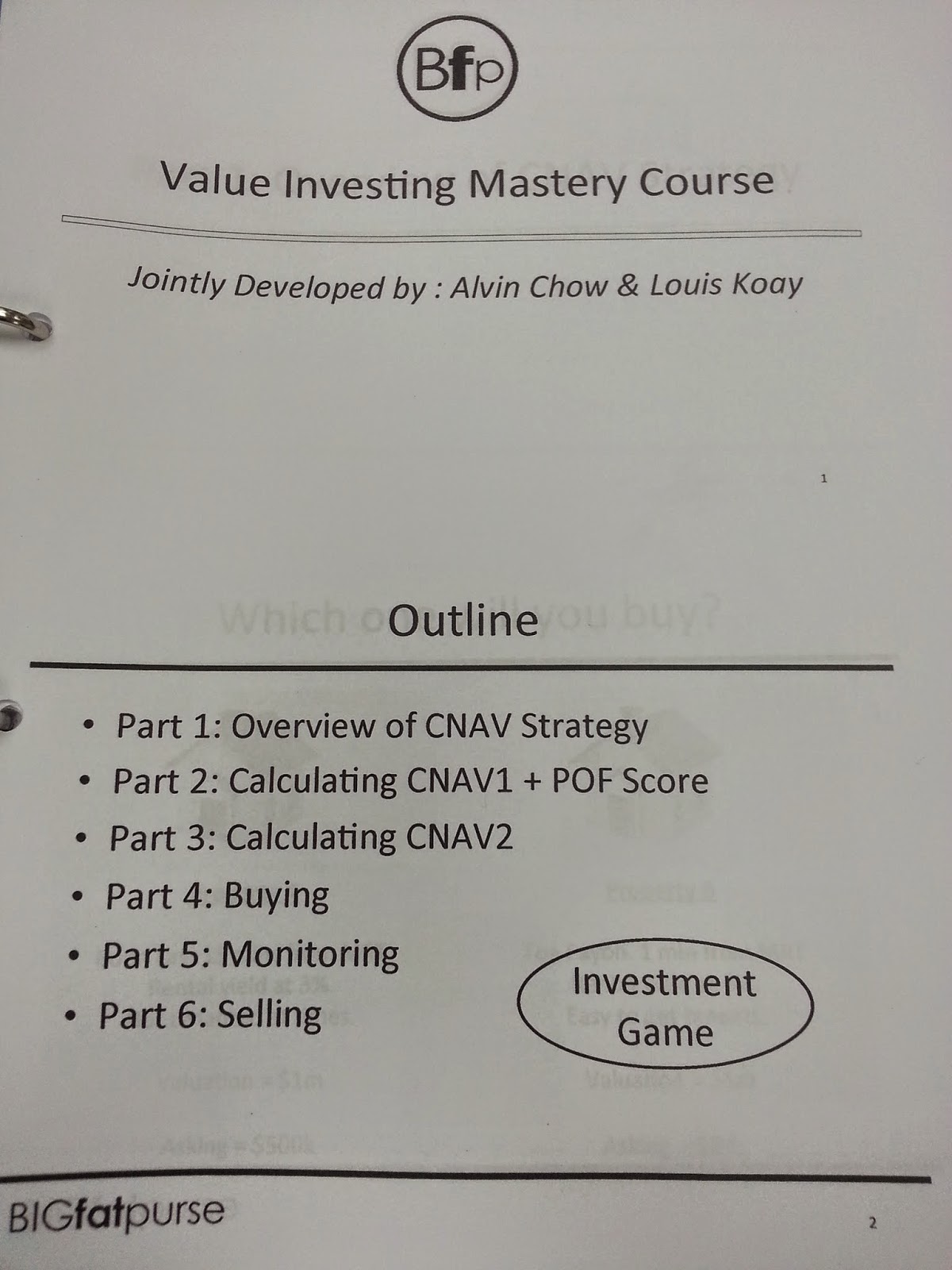Coming from a back to back 6 hours examination for Investment Banking and Private Equity I took on Saturday, I attended the course on Value Investing Mastery Course (VIMC) on Sunday organized by Bigfatpurse, made up of Alvin, Louis, Jon and Alex. I need to thank Alvin and the team for inviting me to the course as I was much geared up to attend this than some of the MBA classes I took at SMU. For some reason, I’ve always been interested to learn something which I can apply to directly rather than learning some theories which I know wasn’t going to be practical. Hint: During schooldays, I knew I wasn’t going to use the concept on integrating Logx or anything in life that resembles like anything I learnt in A Maths.


What is the Course about?
This course isn’t about teaching you the Warren Buffett’s way of valuing a company through earnings or cash flow. This course is about teaching you the Walter Schloss‘ way of valuing companies through net asset value. Unlike Buffett, Schloss does not invest based on earnings as they are harder to estimate over time and they tend to fluctuate more than the value of an asset.

The Bigfatpurse team further breaks it down into what they called as CNAV (Conservative Net Asset Value). I do not want to spill too much into the detail of how they calculate the CNAV but what they are taking with this is basically the different percentage allocation of certain asset categories which weigh more importance than the others. Think intangible and cash for example. By differentiating the lesser value asset categories, you are able to take a more conservative stance in computing your NAV. The lower your buying price relative to the CNAV you have computed, the better it is for you.
I like the fact that the team went further into evaluating some of the other financial indicators through their POF score – Profitability, Operating Efficiency and Financial Leverage. Again, I do not want to spill too much information in my writing at this point in time regarding the concept. In the MBA class I attended, we were taught to use the extended Dupont RoE to account for this financial indicators, so the same concept with Profitability (Profit Margins), Operating Efficiency (Assets Turnover) and Financial Leverage (Debt to Equity) are there.
The course also teaches you the point of entry and exit with clear strict indication, so the directions are given and it is up to the retail investors to be diligent enough to do it.
My Thoughts
I thought the course was well delivered by Alvin and Louis.
The content was simple to understand for most of the crowd and various accounting terms were explained in a simple and clear manner. There was also a formula sheet that allows you to calculate the CNAV of a company in about 15 minutes (or less once you are more familiar). I get the impression that most investors are now quite confident in calculating the formula but there are one or two that gets rather lost with all the computation.
Regarding the POF, I would personally like to use the Profitability margins instead of the Price to Earnings Ratio in measuring the Profitability indicators, but that is just my personal preference. I also spoke to Alvin regarding the use of Free Cash Flow to replace the Operating Cash Flow method in measuring the Operating Efficiency as it is more conservative but we agreed that it would make the calculation much more complex than it seemed to be. Maybe this would make a great learning tools for a more advance classes if they decide to have it one day.
Last but not least, I think the breakout for the investment game was very fun and entertaining and it shows how difficult it can be when it comes to investing. My team unfortunately came in 4th so we did not manage to get the prize money.
$98 and $1888
I thought for $98, it was one of the cheapest course you will ever get in the market out there with the amount of knowledge you bring home. The team also has a list of CNAV databases and lifetime coaching regarding portfolio management etc valued at $1,888 which I thought was very reasonable. If you believe in the strategy, I thought it is a no brainer to get the whole package as the team has a wealth of knowledge that you can tap on other than just the CNAV. For example, I have a 70 year old retiree in my team and portfolio management would become one of the more important factors in his investing decision.
Overall, I really enjoyed the session and I have learned a great deal from the course in just one single day.
Once again, I would like to thank the BFP team and should you too be interested in this course, you can check out their link VIMC.
P.s: This is not a paid advertisement and everything written is purely my own personal opinion about the course.


I attended the course too and find it useful and practical, CNAV is still one the default tool to use when I analyse the stocks. Of course, I do practice some variation of % to apply depending on the stocks I am assessing.
Hi Richard
indeed, I think i learned a great deal from the course as well and I will integrate it with my strategy when making a purchase.
Hi B,
We were suppose to attend the course a few weeks ago but unfortunately you couldn't make it back then. If not we would have met 🙂
Hi SGYI
Yes its a pity not to be able to meet up with you a few weeks back.
hopefully we'll do soon though.
Hi B,
I actually thought of attending the course too, to support my fellow NTU engineering counterpart in Big fat purse. They are quite fully booked I think.
Rolf
Riverstone Training will be holding a series of Smart Training Classes in Singapore for Investment Banking in coming month. Interested attendees will need to contact directly for class.